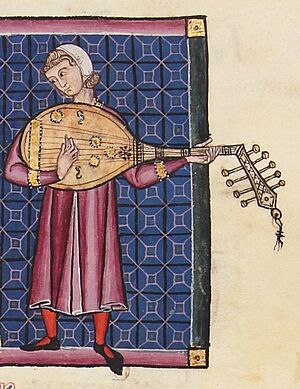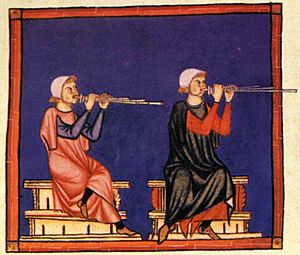Cantigas de Santa Maria facts for kids
The Cantigas de Santa Maria are a collection of 420 poems with music. They were written in the old Galician-Portuguese language during the time of King Alfonso X of Castile, who was also known as El Sabio (The Wise). He ruled from 1221 to 1284.
People used to think King Alfonso wrote all of them. But now, experts believe that many musicians and poets in his court wrote most of the songs. King Alfonso probably wrote a few himself.
This collection is one of the biggest groups of solo songs from the Middle Ages. Every song in the collection mentions the Virgin Mary. Also, every tenth song is a special hymn (a song of praise).
The Cantigas are kept in four old books, called manuscripts or codices. Two are in El Escorial, one is in Madrid's National Library, and one is in Florence, Italy. The 'E' codex from El Escorial has beautiful, colorful pictures called miniatures. These pictures show pairs of musicians playing many different instruments. The 'Códice Rico' (T) from El Escorial and the one in Florence (F) also have rich pictures that tell stories.
What are the Cantigas?
The Cantigas were written in an early form of Galician, which was part of the Galician-Portuguese language. This language was very popular for writing songs in Castile at that time. King Alfonso X had also spent some of his early years in Galicia, so he likely spoke the language very well since he was a child.
The collection has 420 poems. Most of them (356) are stories about miracles performed by the Virgin Mary. The other songs, except for an introduction and two prologues, are songs of praise or are about Marian festivals. The Cantigas show the Virgin Mary in a very human way. She often plays a part in everyday events on Earth.
We don't know for sure who wrote all the Cantigas. Some studies suggest that a Galician poet named Airas Nunes might have written many of them. King Alfonso X, who is called Affonso in the Cantigas, is also thought to have written some. He even refers to himself in the first person in some songs. This idea is supported by the prologue of the Cantigas. Many sources also give Alfonso credit because he influenced other poetic works.
Even though it's debated how many songs King Alfonso X wrote, his influence is clear. Other major works from Alfonso's workshops, like history books, were in Castilian. But the Cantigas are in Galician-Portuguese. This shows how popular other song collections, like the cantigas d'amigo and cantigas d'amor, were in the Castilian court.

The songs have many different musical styles. There are 280 different formats for the 420 Cantigas. The most common styles are the virelai and the rondeau. The length of the song lines can be from two to 24 syllables.
The music is written using a special notation. It is similar to the notation used for church chants, but it also gives some clues about how long the notes should be played. Today, many groups that play early music perform and record the Cantigas. You can find many CDs with music from the Cantigas.
The Old Books (Codices)
The Cantigas are kept safe in four important old books:
- To (the Toledo codex, found in the Biblioteca Nacional de España, MS 10069, link to manuscript)
- T (the rich codex, found in the Biblioteca de El Escorial, MS T.I.1, link to manuscript)
- F (the Florence codex, found in Florence, Biblioteca Nazionale, MS b.r. 20, link to manuscript)
- E (the musicians' codex, found in the Biblioteca de El Escorial MS B.I.2, link to manuscript)
The 'E' codex has the most songs, with 406 Cantigas, plus an introduction and a prologue. It also has 41 very detailed small pictures and many decorated letters. The 'To' codex is the oldest collection and has 129 songs. It doesn't have pictures, but it is beautifully decorated with fancy initial letters.
The 'T' and 'F' manuscripts are like sister books. 'T' has 195 Cantigas that are still complete (8 are missing because pages were lost). These songs are in roughly the same order as the first 200 songs in 'E'. Each song in 'T' has either 6 or 12 small pictures that show scenes from the song. 'F' follows the same style but only has 111 Cantigas. Seven of these have no words, only pictures. These songs are a smaller group of those found in the second half of 'E', but they are in a very different order. The 'F' codex was never finished, so no music was ever added. Only empty lines for music show that they planned to add it later.
Most people believe these old books were made during King Alfonso's lifetime. 'To' might have been made in the 1270s, and 'T', 'F', and 'E' in the early 1280s, up until he died in 1284.
The Music of the Cantigas
Experts are still studying the many musical forms found in the Cantigas. It can be tricky to figure out the exact rhythm of the music. However, much progress has been made in understanding these old songs over the last 20 years.
See also
 In Spanish: Cantigas de Santa María para niños
In Spanish: Cantigas de Santa María para niños
- Literature of Alfonso X
- Cantiga de amigo
- Llibre Vermell de Montserrat
- Pergaminho Sharrer
- Martin Codax
- The Legend of Ero of Armenteira



